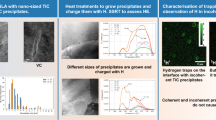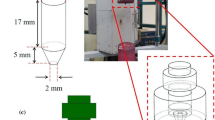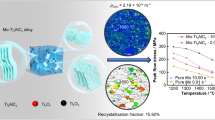Abstract
Destructive hydrogenation and recombination are realized in powder and melted samples of TiNi under mild barothermal conditions (\(P_{H_2 } \) = 1.5 MPa, T = 773 K). Phase transformations during preliminary annealing, destructive hydrogenation and recombination are studied. During annealing of the original TiNi specimens with a predominantly austenitic structure and considerable internal stresses there is austenite-martensite transformation giving rise to formation of two-phase austenite-martensite titanium nickelide. During destructive hydrogenation an indestructible composite forms with Ni3Ti and (or) Ni-matrix within which there are uniformly distributed titanium hydride inclusions. The TiH2-Ni3Ti-Ni composite formed has a high hydrogen capacity compared with the original TiNi. During recombination titanium nickelide with an austentic structure is synthesized from TiH2, Ni3Ti and Ni. Here the original grain size is reduced on average by a factor of two.
Similar content being viewed by others
Refrences
V. N. Verbetskii, Synthesis and Properties of Multicomponent Metal Hydrides, PhD Thesis [in Russian], Moscow (1998).
V. A. Yartys’, I. R. Garris, and V. V. Panasyuk, “New metal hydrides: Review,” Fiz.-Khim. Mekhan. Materialov, No. 4, 69–86 (2001).
I. I. Bulyk, A. M. Trostyanchin, V. G. Sinyushko, and I. V. Sokal’skaya, “Phase transformations in the system LaNi5−x Cox-H2,” VIII Internat. Conf. “Hydrogen materials science and chemistry of carbon nanomaterials” (September 14–20, 2003, Sudak), Kiev (2003).
I. V. Saldan and I. Yu. Zavalii, “Effect of oxygen modification, alloying and HDDR treatment on the charge-discharge characteristics of MH-electrodes based on Ti2Ni,” VIII Internat. Conf. “Hydrogen materials science and chemistry of nanomaterials” (September 14–20, 2003, Sudak), Kiev (2003).
I. I. Bulyk, V. V. Panasyuk, A. N. Trostyanchin, et al., “Metallographic study of phase transformations during solid-HDDR in ferromagnetic alloys based on the compound Dy2Fe14B,” VIII Internat. Conf. “Hydrogen materials science and chemistry of nanomaterials” (September 14–20, 2003, Sudak), Kiev (2003).
T. I. Bratanich, T. V. Permyakova, and V. V. Skorokhod, “Study of destructive hydrogenation of powder intermetallic systems. I. Thermodynamic analysis of direct and destructive hydrogenation of intermetallics,” Poroshk. Metall., Nos. 11–12, 93–100 (2004).
T. I. Britanich, S. M. Solnin, V. Ya. Petrishchev, and V. V. Skorokhod, “Dilatation investigation of porous intermetallic samples during reversible hydrogenation,” Int. J. Hydrogen Energy, 21, Nos.11–12, 1115–1120 (1996).
B. A. Kolachev, R. E. Shalin, and A. A. Il’in, Alloys Hydrogen Accumulators: Handbook [in Russian], Metallurgiya, Moscow (1995).
M. Kh. Karapet’yants and M. L. Karapet’yants, Basic Thermodynamic Constants of Inorganic and Organic Substances [in Russian], Khimiya, Moscow (1968).
B. A. Kolachev, A. A. Il’in, V. A. Lavrenko, and Yu. V. Levinskii, Hydride Systems: Handbook [in Russian], Metallurgiya, Moscow (1992).
Author information
Authors and Affiliations
Additional information
__________
Translated from Poroshkovaya Metallurgiya, Nos. 11–12(452), pp. 87–93, November–December, 2006.
Rights and permissions
About this article
Cite this article
Bratanich, T.I., Get’man, O.I., Dobrovol’skii, V.D. et al. Phase transformations and change in TiNi intermetallic compound structure during destructive hydrogenation and recombination. Powder Metall Met Ceram 45, 582–587 (2006). https://doi.org/10.1007/s11106-006-0122-x
Received:
Issue Date:
DOI: https://doi.org/10.1007/s11106-006-0122-x




